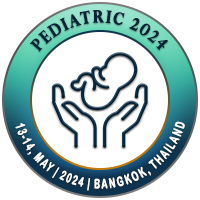
Biplob Kumar Raha
Combined Military Hospital Dhaka, BangladeshTitle: Risk factors and clinical profile of respiratory distress in newborn: A hospital based study in Bangladesh army
Abstract
Background: Neonatal Respiratory Distress (NRD) is a main cause of neonatal morbidity and mortality in developing countries. Early detection of its risk factors and early treatment of its causes are major challenges. There are many causes of respiratory distress, among them, Transient Tachypnea of Newborn (TTN), Respiratory Distress Syndrome (RDS) and perinatal asphyxia are commonest causes. Timely and appropriate therapy is essential to prevent ongoing injury and improve outcome.
Objectives: The aim of this study was to determine the risk factors and to identify the causes of respiratory distress in Neonatal Intensive Care Unit (NICU) in Combined Military Hospital (CMH) Sylhet and to observe the hospital outcome of these babies.
Methods: A descriptive type of cross- sectional study was conducted in CMH Sylhet over a period of one year from April 2018 to March 2019. During the study period a total of 287 live newborns were found and included as study subjects to observe for development of respiratory distress.
Results: The overall prevalence of respiratory distress was 19.2%. There was male predominance (63.6%) and two third (71.1%) were born by cesarean section. Prematurity (38.2%), low birth weight (52.7%), male gender (63.6%), APGAR at 1 min < 7 (10.9%), caesarean delivery (76.4%), less antenatal care visit (52.7%), more than 4 pervaginal examinations (49.1%), acute fetal distress (43.6%) and gestational diabetes mellitus (34.5%) were the most common risk factors for development of NRD. The main causes were transient tachypnea of newborn (47.3%), respiratory distress syndrome (29.1%) and perinatal asphyxia (10.9%). All babies required high flow oxygen initially, subsequently Bubble Continuous Positive Airway Pressure (CPAP) and mechanical ventilation was required in 8 (14.5%) and 1(1.8%) case respectively. Mortality was 1.8% in neonates with respiratory distress syndrome with pneumothorax with septicemia requiring mechanical ventilation.
Conclusion: NRD is a frequent emergency and causes high morbidity and mortality. Risk factors like prematurity, low birth weight, male gender, APGAR at 1 min < 7, caesarean delivery, less antenatal care visit, more than 4 pervaginal examinations, acute fetal distress and gestational diabetes mellitus were associated with respiratory distress in newborns. Majority of cases are due to TTN followed by respiratory distress syndrome and perinatal asphyxia. Mortality was in RDS mainly related to pneumothorax with septicemia. Better obstetrical care and timely intervention may improve the outcome of newborn respiratory distress.
Biography
Biplob Kumar Raha is a child specialist in Sylhet. His qualification is MBBS, CCD (BIRDEM), FCPS (pediatrics), advanced training (neonatology). He is a consultant in pediatrics at Combined Military Hospital, Sylhet, Bangladesh.

